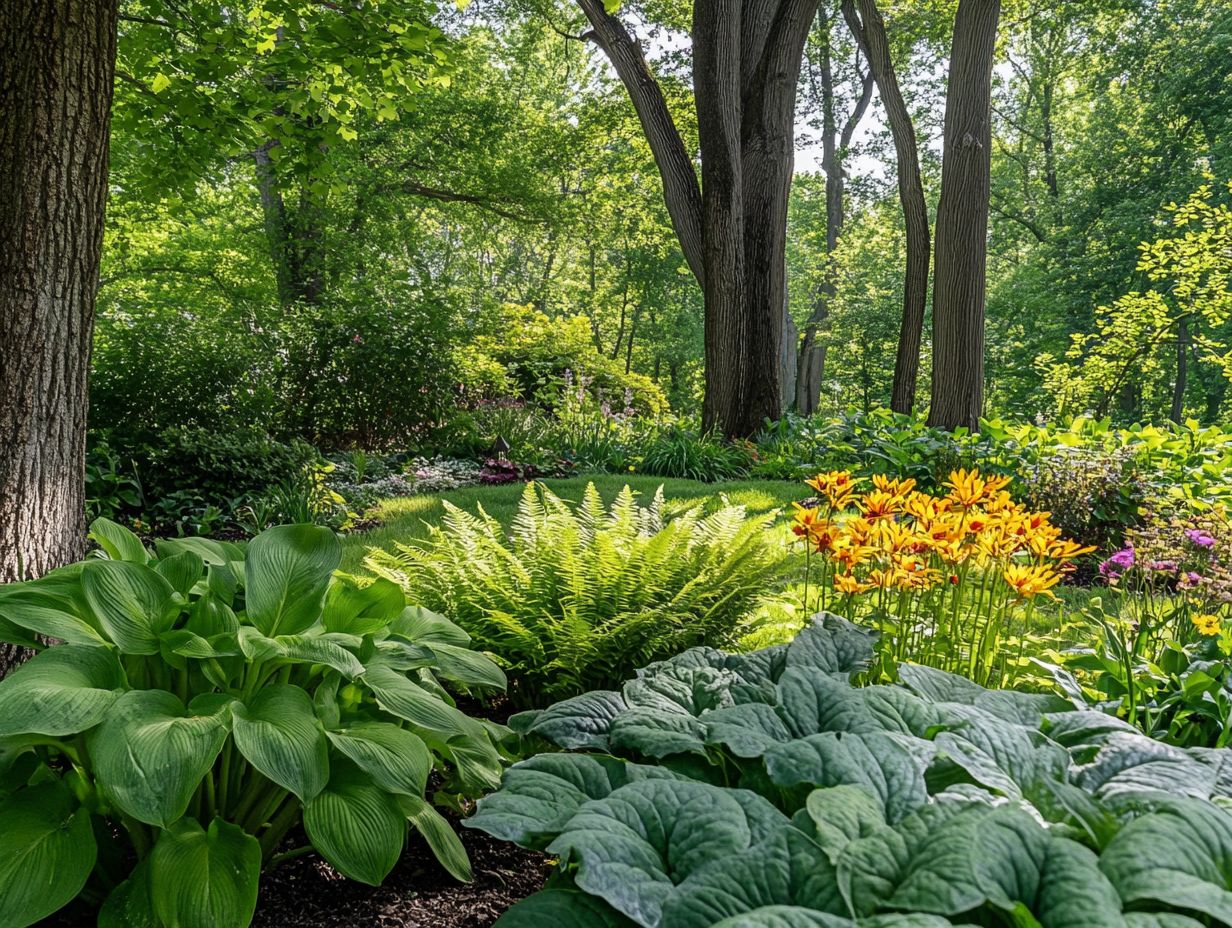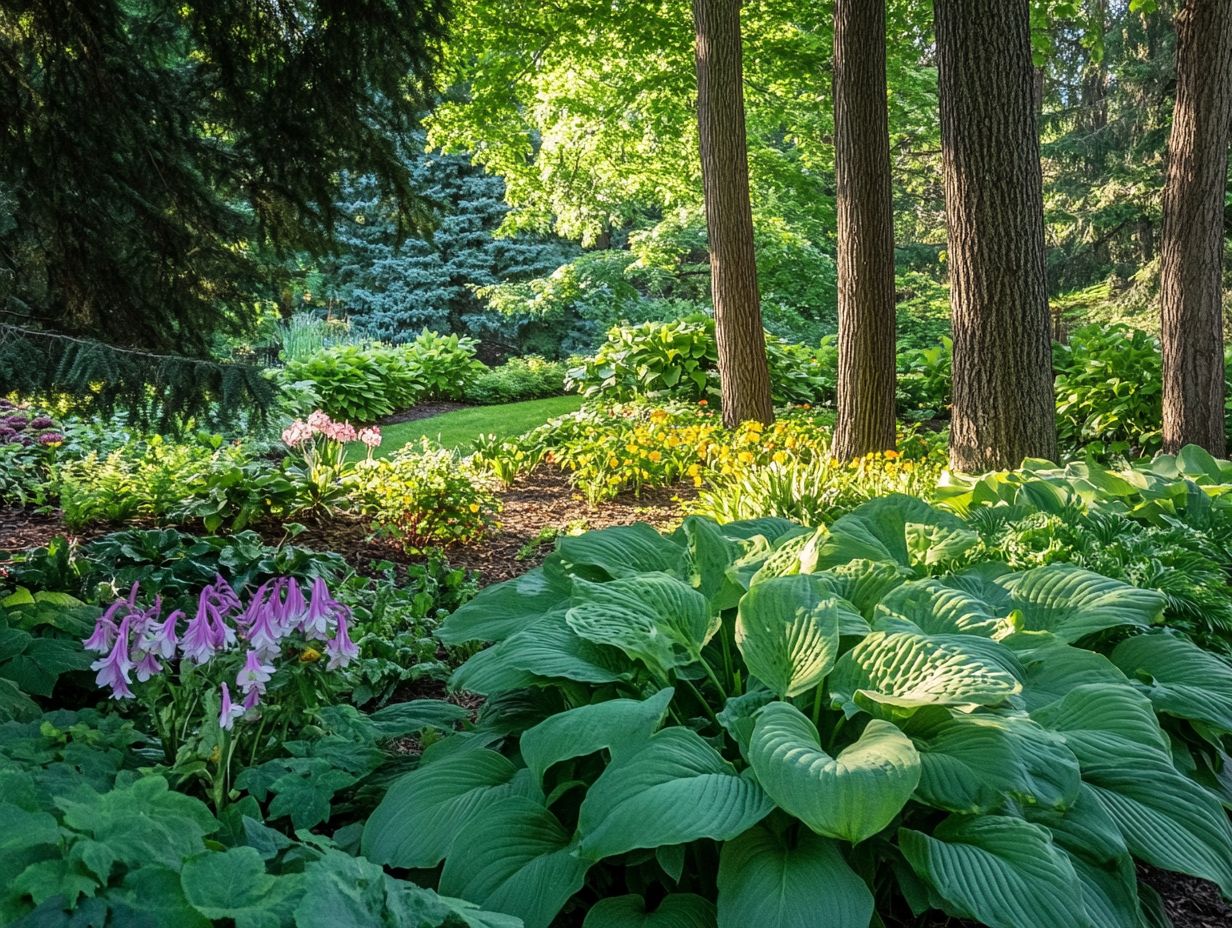Selecting Plants for Shade in Cold Climates
Creating a thriving garden in shaded, cold climates presents an enriching challenge that can bring great satisfaction, especially for gardening enthusiasts.
This guide is designed to illuminate the unique factors you must consider when selecting plants that thrive in limited sunlight and cooler temperatures. Dive into the world of shade-loving perennials, annuals, and shrubs while gaining insight into hardiness areas and winter survival strategies to identify the perfect specimens.
You ll also find valuable tips on planting and maintenance. This knowledge will empower you to cultivate a breathtaking shade garden that flourishes throughout the seasons.
Contents
- Key Takeaways:
- Understanding Shade and Cold Climates
- Types of Shade Plants
- Hardiness Zones and Cold Tolerance
- Factors to Consider in Planting and Maintenance
- Creating a Beautiful Shade Garden
- Frequently Asked Questions
- What are some important factors to consider when selecting plants for shade in cold climates?
- Are there any specific types of plants that are best suited for shade in cold climates?
- Can I still have a diverse and visually appealing garden if I am limited to selecting plants for shade in cold climates?
- Do I need to take any extra precautions when planting and caring for shade plants in cold climates?
- Can I grow vegetables and herbs in shade in cold climates?
- What are some low-maintenance options for selecting plants for shade in cold climates?
Key Takeaways:

Understanding Shade and Cold Climates
Understanding shade and cold climates is crucial for cultivating a flourishing garden adorned with shade-tolerant plants for cold climates. These environments can present challenges, especially when you must consider soil quality, plant hardiness, and water requirements.
Cold climates often narrow your choices for thriving plants. However, by opting for native species that align with local conditions and understanding soil needs for cold-climate plants, you can create an outdoor sanctuary that encourages wildlife interaction and bolsters ecosystem balance.
Using local gardening resources and seeking recommendations will empower you to make informed decisions about plant selection and garden design. This ensures your gardening efforts are both rewarding and environmentally enriching.
Factors to Consider in Plant Selection
When selecting plants for your shade garden, it’s essential to consider several key factors, including the best native plants for cold climates, that will ensure vibrant foliage and seasonal interest.
Understanding your local plant hardiness areas is crucial, as it dictates which plants will flourish in your specific environment. Equally important is assessing soil quality, as testing for pH levels and drainage can significantly impact plant health. Evaluating the water needs of your chosen plants will help you craft a balanced watering schedule that promotes growth while preventing root rot.
Opting for shade-loving plants like ferns or hostas not only enhances the beauty of your garden but also provides a lush atmosphere. Incorporating organic matter into the soil will improve both fertility and structure, setting the foundation for success.
Don t overlook the value of local gardening extensions, which often recommend specific varieties tailored to your region, ensuring that your selections will perform at their best.
Types of Shade Plants
You have access to an impressive array of shade plants, from vibrant flowering perennials to lush foliage species and resilient groundcovers. These selections can flourish in partly shaded areas, elevating the visual allure of your garden and creating a captivating landscape.
Perennials, Annuals, and Shrubs for Shade

Choosing the right mix of perennials, annuals, and shrubs can transform your shade garden. It will create a vibrant space that attracts pollinators.
Imagine adding lively shade-loving annuals like impatiens and coleus, infusing your garden with bursts of color throughout the season. Simultaneously, classic perennials like hostas and ferns provide a lush backdrop of greenery and texture.
Incorporating shrubs such as azaleas or hydrangeas not only establishes structure but also introduces blooms that evolve with the seasons, ensuring your garden remains captivating year-round.
By engaging with a local nursery, you can elevate your plant selection experience. Their expertise will guide you in identifying varieties that thrive in your specific climate and conditions, leading to a flourishing and harmonious garden that truly reflects your vision.
Your journey to a stunning shade garden starts now. Get your hands in the soil and let nature thrive!
Hardiness Zones and Cold Tolerance
Understanding hardiness zones—the temperature ranges where plants can survive—is essential for selecting shade plants that will thrive in cold climates. These zones provide crucial information about the temperature ranges in which different species can flourish, guiding you in making informed choices, such as selecting the right containers for cold-climate plants, for your garden.
Choosing Plants that Can Survive Winter
Selecting plants that can withstand winter is essential for ensuring your shade garden flourishes during the colder months. By exploring sustainable plant choices for cold climates, you can enhance your efforts with specific strategies.
Consider the local climate conditions and choose species renowned for their resilience in chilly temperatures. For instance, exploring the top 10 low-maintenance plants for cold climates can provide great options. Collaborating with nearby plant nurseries can offer invaluable insights into which varieties thrive in your region, as they typically stock plants specifically bred for winter survival.
Keeping a gardening diary can be a game changer; documenting each plant’s performance enables you to reflect on what thrived and what didn t. This ongoing assessment gives you the power to make informed decisions for future planting, ultimately nurturing a robust, sustainable garden that retains its vibrancy, even amid winter’s chill.
Factors to Consider in Planting and Maintenance
Grasping the details of planting and maintenance is crucial for cultivating a shade garden that thrives in both longevity and vibrancy.
Soil, Water, and Light Requirements

The success of your shade garden hinges on a keen understanding of the soil, water, and light requirements that shade-loving plants demand. To cultivate an environment that promotes growth and longevity, your first step should be to focus on the specific soil quality these plants thrive in.
You’ll want well-draining soil enriched with compost and organic matter not just for fertility, but also for enhancing moisture retention. This nutrient-rich foundation supports a diverse array of plants, from ferns to hostas.
When considering water needs, keep in mind that plants in shady areas typically require less frequent watering compared to their sun-loving counterparts. Regularly assessing light conditions, whether dappled or deeply shaded, helps ensure that your plants thrive in a vibrant health.
Creating a Beautiful Shade Garden
Creating a stunning shade garden is an exciting journey. Thoughtful design and strategic plant choices can truly make a difference!
Each element should harmonize to create a visual symphony that enchants and draws in the beholder.
Tips for Design and Plant Combinations
Effective design tips and plant combinations can elevate any shade space into a vibrant ecosystem that supports local wildlife and bolsters the community’s economy.
By carefully selecting a diverse array of shade-loving plants, you can craft an eye-catching landscape that thrives across the seasons while nurturing a healthy habitat for pollinators and other creatures. Incorporating flowering species that bloom at different times guarantees a continuous display of color and life, attracting birds and beneficial insects throughout the year.
Opting for native plants can significantly enhance ecological balance and minimize maintenance efforts. Supporting local nurseries and gardening initiatives is another excellent way to positively impact your community. It promotes economic growth and encourages the sharing of knowledge about sustainable practices, ultimately enriching your overall gardening experience.
Frequently Asked Questions
What are some important factors to consider when selecting plants for shade in cold climates?

When selecting plants for shade in cold climates, it is important to consider their hardiness zone, resistance to frost and snow, and adaptability to low light conditions. Additionally, understanding plant selection for cold-climate design helps ensure you choose plants with a longer growing season to thrive in colder temperatures.
Start your shade garden today and enjoy a vibrant oasis even in the cold!
Share your gardening experiences or seek help at local nurseries to create a supportive gardening community!
Are there any specific types of plants that are best suited for shade in cold climates?
Yes, several types of plants thrive in shade and cold climates. Consider evergreens like holly and spruce, along with selecting trees for cold-climate landscaping, plus shade-loving plants like hostas and ferns.
Choose plants native to your area. They adapt better to the local climate.
Can I still have a diverse and visually appealing garden if I am limited to selecting plants for shade in cold climates?
Definitely! You’ll be amazed by the beauty you can achieve. There are many beautiful and unique plants that thrive in shade and colder temperatures.
Incorporate a mix of evergreens, flowering shrubs, and perennials plants that live for more than two years with varying textures, colors, and heights to create a visually appealing and diverse garden.
Do I need to take any extra precautions when planting and caring for shade plants in cold climates?
Yes, it’s crucial to prepare the soil properly before planting. Use a layer of mulch to protect the plants’ roots from freezing temperatures.
Regularly water and fertilize shade plants, as they typically have less access to sunlight and nutrients.
Can I grow vegetables and herbs in shade in cold climates?
Yes! Certain vegetables and herbs thrive in shade and colder temperatures. For example, leafy greens like spinach and kale, as well as herbs like mint and chives.
Research and choose varieties specifically suited for growing in shade and colder climates.
What are some low-maintenance options for selecting plants for shade in cold climates?
If you seek low-maintenance options, plant native species, as they are better adapted to the climate and require less care.
Choose plants with a longer lifespan, like shrubs or trees, which will need less frequent replanting or maintenance. Use a layer of mulch to help retain moisture and reduce the need for frequent watering.






